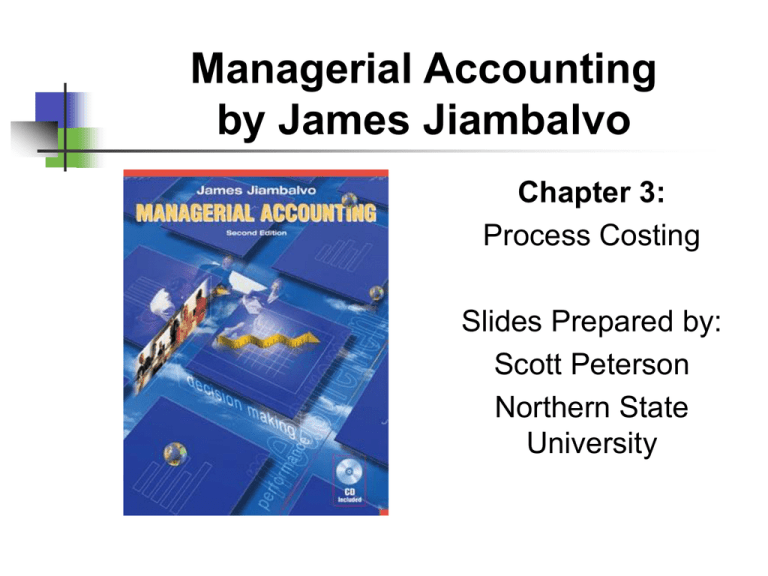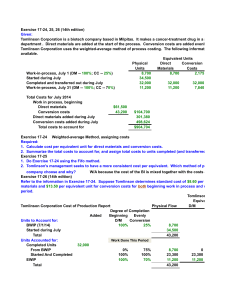
Managerial Accounting
by James Jiambalvo
Chapter 3:
Process Costing
Slides Prepared by:
Scott Peterson
Northern State
University
Objectives
1. Describe how products flow through
departments and how costs flow
through accounts.
2. Discuss the concept of an equivalent
unit.
3. Calculate the cost per equivalent unit.
4. Calculate the cost of goods completed
and the ending Work in Process
balance in a processing department.
5. Describe a production cost report.
Difference Between Job-Order
and Process Costing Systems
Job-Order Costing Systems assign costs
to heterogeneous jobs.
Process Costing Systems spread total
manufacturing costs over total,
homogenous, units produced.
Difference Between Job-Order
and Process Costing Systems
Product and Cost Flows
1. Product Flows Through Departments
2. Cost Flows Through Accounts
3. Conversion Costs
Product Flows Through
Departments
Cost Flows Through Accounts
Calculating Unit Cost
To compute unit costs it is first necessary
to compute Equivalent Units.
How Equivalent Units are
Calculated
Cost Per Equivalent Unit
Average unit cost in a Process Costing
System is calculated as follows:
Cost Per Equivalent Unit =
Cost in BWIP + Costs incurred currently
Units completed + Equivalent units in EWIP
Calculating and Applying Cost
Per Equivalent Unit: Mixing
Department Example
Units:
BWIP:10,000 gallons, 80% complete labor/overhead
Started:70,000 gallons, 60,000 completed
EWIP:20,000 gallons, 50% complete.
Costs:
BWIP:$18,000 material, $7,800 labor, $23,400 overhead
Added:$142,000 of material, $62,200 labor
Overhead: applied at a predetermined rate of $3 per
dollar of labor or $186,600.
Calculating and Applying Cost
Per Equivalent Unit: Mixing
Department Example
Calculate: Cost per equivalent unit.
Answer: $6
Solution:
Material: $160,000/80,000=$2
Labor:
$ 70,000/70,000=$1
Overhead: $210,000/70,000=$2
Total Costs/Unit:
=$6
Calculating and Applying Cost
Per Equivalent Unit: Mixing
Department Example
Calculating and Applying Cost
Per Equivalent Unit: Mixing
Department Example
Calculating and Applying Cost
Per Equivalent Unit: Mixing
Department Example
Production Cost Report
Production Cost Report Contains:
1. Reconciliation of units.
2. Reconciliation of costs.
3. Details of the cost per equivalent unit
calculations.
Reconciliation of Units
BWIP + the number of units started = the
number of units completed EWIP.
Reconciliation of Costs
BWIP + costs added = costs transferred
out + EWIP.
Basic Steps in Process
Costing: A Summary
1. Account for the number of physical
units.
2. Calculate the cost per equivalent unit
for material, labor and overhead.
3. Assign cost to items completed and
items in EWIP.
4. Account for the amount of product
cost.
Dealing With Transferred-In
Costs
1. Process Costing Systems generally
use several processes; not just one.
2. Transferred-In costs are treated just
like other product costs (l.e. material,
labor and overhead).
3. Ultimately all costs, including those
transferred in, are transferred to
Finished Goods.
Process Costing and
Incremental Analysis
1. Decisions are based on costing
information obtained through Process
Costing Systems.
2. Incremental Analysis is frequently
used to make these decisions.
3. Be wary and recall that Process
Costing Systems capture both fixed
and variable costs.
Quick Review Question #1
1. The best example of a business
requiring a process costing system
would be a(n);
a. Soap manufacturer.
b. Automobile repair shop.
c. Custom cabinet shop.
d. Antique furniture restorer.
Quick Review Answer #1
1. The best example of a business
requiring a process costing system
would be a(n);
a. Soap manufacturer.
b. Automobile repair shop.
c. Custom cabinet shop.
d. Antique furniture restorer.
Quick Review Question #2
2. Costs in a process costing system are
ultimately traced to
a. Specific processes.
b. Specific customers.
c. Specific jobs.
d. Specific production personnel.
Quick Review Answer #2
2. Costs in a process costing system are
ultimately traced to
a. Specific processes.
b. Specific customers.
c. Specific jobs.
d. Specific production personnel.
Quick Review Question #3
3. BWIP consisted of 2,500 units, 100%
complete for materials and 60% for
conversion costs. 8,000 additional
units were started. 9,000 units were
completed and transferred out. How
many physical units are in EWIP?
a. 1,500.
b. 10,500.
c. 14,500.
d. 0.
Quick Review Answer #3
3. BWIP consisted of 2,500 units, 100%
complete for materials and 60% for
conversion costs. 8,000 additional
units were started. 9,000 units were
completed and transferred out. How
many physical units are in EWIP?
a. 1,500.
b. 10,500.
c. 14,500.
d. 0.
Quick Review Question #4
4. Using question #3 data, assume
ending inventory was 100% complete
for materials and 80% complete for
conversion costs? Calculate
equivalent units of production for
materials and conversion costs.
a. 6,500 & 6,500
b. 8,000 & 6,500
c. 8,000 & 8,700
d. 9,000 & 8,700
Quick Review Answer #4
4. Using question #3 data, assume
ending inventory was 100% complete
for materials and 80% complete for
conversion costs? Calculate
equivalent units of production for
materials and conversion costs.
a. 6,500 & 6,500
b. 8,000 & 6,500
c. 8,000 & 8,700
d. 9,000 & 8,700
Copyright
© 2004 John Wiley & Sons, Inc. All rights reserved.
Reproduction or translation of this work beyond that
permitted in Section 117 of the 1976 United States
Copyright Act without the express written permission of the
copyright owner is unlawful. Request for further information
should be addressed to the Permissions Department, John
Wiley & Sons, Inc. The purchaser may make back-up
copies for his/her own use only and not for distribution or
resale. The Publisher assumes no responsibility for errors,
omissions, or damages, caused by the use of these
programs or from the use of the information contained
herein.





